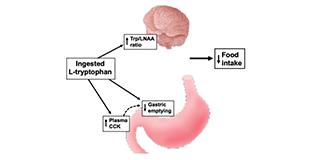当前位置:
X-MOL 学术
›
Food Funct.
›
论文详情
Our official English website, www.x-mol.net, welcomes your feedback! (Note: you will need to create a separate account there.)
Effects of intragastric tryptophan on acute changes in the plasma tryptophan/large neutral amino acids ratio and relationship with subsequent energy intake in lean and obese men.
Food & Function ( IF 6.1 ) Pub Date : 2020-07-28 , DOI: 10.1039/d0fo00773k Maryam Hajishafiee 1 , Sina S Ullrich , Robert E Steinert , Sally D Poppitt , Natalie D Luscombe-Marsh , Michael Horowitz , Christine Feinle-Bisset
Food & Function ( IF 6.1 ) Pub Date : 2020-07-28 , DOI: 10.1039/d0fo00773k Maryam Hajishafiee 1 , Sina S Ullrich , Robert E Steinert , Sally D Poppitt , Natalie D Luscombe-Marsh , Michael Horowitz , Christine Feinle-Bisset
Affiliation

|
Circulating tryptophan/large neutral amino acids (tryptophan/LNAA) ratio, an indicator of brain serotonin levels, may be important in appetite regulation, together with gastrointestinal (gastric emptying, plasma cholecystokinin) mechanisms. We have compared effects of intragastric tryptophan (‘Trp’) on the plasma tryptophan/LNAA ratio in lean and obese men, and the associations of the tryptophan/LNAA ratio, gastric emptying and CCK concentrations with energy intake. Lean and obese male participants (n = 16 each) received 3 g Trp or volume-matched control intragastrically, 15 min before a mixed-nutrient drink (300 mL, 400 kcal) (t = 0 min) in randomised, double-blind fashion. Plasma amino acid (for calculation of the plasma tryptophan/LNAA ratio) and CCK concentrations were measured from t = −20–60 min. Gastric emptying was assessed from t = 0–60 min, and ad-libitum energy intake from a standardised buffet-style meal from t = 60–90 min. The increase in the plasma tryptophan/LNAA ratio was less in obese, than lean, participants (P < 0.05), and greater in lean participants who reduced their energy intake (by >0 kcal) after Trp compared with those who did not (by ≤0 kcal) (P < 0.05). Moreover, in participants who reduced their energy intake, the ratio was lower in obese, than in lean (P < 0.05). There was a trend for an inverse correlation between energy intake with the plasma tryptophan/LNAA ratio in lean (r = −0.4, P = 0.08), but not in obese, participants. There was no significant difference in gastric emptying or CCK between participants who reduced their energy intake and those who did not. In conclusion, the plasma tryptophan/LNAA ratio appears to be a determinant of the suppression of energy intake in response to tryptophan in normal-weight people, but not in those with obesity. The role of the plasma tryptophan/LNAA ratio to regulate energy intake, and potential changes in obesity, warrant evaluation in prospective studies.
中文翻译:

胃内色氨酸对瘦男人和肥胖男人血浆色氨酸/大中性氨基酸比例的急性变化及其与随后能量摄入的关系。
循环色氨酸/大中性氨基酸(色氨酸/ LNAA)的比率(脑中5-羟色胺水平的指标)与胃肠道(胃排空,血浆胆囊收缩素)机制一起可能对食欲调节很重要。我们比较了肥胖和肥胖男性中胃内色氨酸('Trp')对血浆色氨酸/ LNAA的影响,以及色氨酸/ LNAA的比率,胃排空和CCK浓度与能量摄入的关系。瘦和肥胖男性参与者(Ñ = 16个)接收3克Trp或体积匹配的对照胃内,15分钟的混合营养饮料(300毫升,400千卡)之前(吨= 0分钟)以随机,双盲的方式。在t = −20–60分钟内测量血浆氨基酸(用于计算血浆色氨酸/ LNAA比)和CCK浓度。从t = 0–60 min评估胃排空,从t = 60–90 min评估标准自助餐的随意摄入能量。肥胖参与者的血浆色氨酸/ LNAA比值增加比瘦者要少(P <0.05),而在Trp后减少能量摄入(> 0 kcal)的瘦参与者则比没有肥胖者更明显(P <0.05)。 ≤0kcal)(P <0.05)。此外,在减少能量摄入的参与者中,肥胖者的比例低于瘦身者(P<0.05)。瘦弱者的能量摄入与血浆色氨酸/ LNAA比值呈负相关(r = -0.4,P = 0.08),而肥胖者则没有。减少能量摄入的参与者与没有减少能量摄入的参与者之间的胃排空或CCK差异无统计学意义。总之,血浆色氨酸/ LNAA比例似乎是正常体重人群对色氨酸的能量摄入抑制的决定因素,而肥胖人群则不然。血浆色氨酸/ LNAA比例在调节能量摄入以及肥胖症的潜在变化中的作用值得在前瞻性研究中进行评估。
更新日期:2020-08-19
中文翻译:

胃内色氨酸对瘦男人和肥胖男人血浆色氨酸/大中性氨基酸比例的急性变化及其与随后能量摄入的关系。
循环色氨酸/大中性氨基酸(色氨酸/ LNAA)的比率(脑中5-羟色胺水平的指标)与胃肠道(胃排空,血浆胆囊收缩素)机制一起可能对食欲调节很重要。我们比较了肥胖和肥胖男性中胃内色氨酸('Trp')对血浆色氨酸/ LNAA的影响,以及色氨酸/ LNAA的比率,胃排空和CCK浓度与能量摄入的关系。瘦和肥胖男性参与者(Ñ = 16个)接收3克Trp或体积匹配的对照胃内,15分钟的混合营养饮料(300毫升,400千卡)之前(吨= 0分钟)以随机,双盲的方式。在t = −20–60分钟内测量血浆氨基酸(用于计算血浆色氨酸/ LNAA比)和CCK浓度。从t = 0–60 min评估胃排空,从t = 60–90 min评估标准自助餐的随意摄入能量。肥胖参与者的血浆色氨酸/ LNAA比值增加比瘦者要少(P <0.05),而在Trp后减少能量摄入(> 0 kcal)的瘦参与者则比没有肥胖者更明显(P <0.05)。 ≤0kcal)(P <0.05)。此外,在减少能量摄入的参与者中,肥胖者的比例低于瘦身者(P<0.05)。瘦弱者的能量摄入与血浆色氨酸/ LNAA比值呈负相关(r = -0.4,P = 0.08),而肥胖者则没有。减少能量摄入的参与者与没有减少能量摄入的参与者之间的胃排空或CCK差异无统计学意义。总之,血浆色氨酸/ LNAA比例似乎是正常体重人群对色氨酸的能量摄入抑制的决定因素,而肥胖人群则不然。血浆色氨酸/ LNAA比例在调节能量摄入以及肥胖症的潜在变化中的作用值得在前瞻性研究中进行评估。



























 京公网安备 11010802027423号
京公网安备 11010802027423号